If you're thinking about getting stronger, improving your fitness, or simply feeling more confident in your body, learning the basics of weight training is a great place to start. Whether you're stepping into a gym for the first time or dusting off those dumbbells at home, understanding the fundamentals of weightlifting can make all the difference in your progress and safety.
What Is Weight Training?
Weight training, sometimes called resistance training or strength training, involves using external resistance—like free weights, machines, or even your own body weight—to stress your muscles. Over time, this stress forces your muscles to adapt, growing stronger and more defined.
It’s important to note that weightlifting basics and weight training basics are not just about how much weight you can lift. They’re about proper form, consistency, and progression. Training smart from the start helps prevent injuries and ensures long-term results.
The Core Principles of Weightlifting
Here are five foundational principles that apply to every weight training routine:
-
Progressive Overload
To build strength and muscle, you must gradually increase the resistance or intensity of your workouts. This could mean adding more weight, increasing reps, or improving form. -
Proper Form First
Always prioritize technique over heavy weights. Poor form not only reduces effectiveness but also increases the risk of injury. Learn the movement patterns—squats, presses, rows—before piling on the plates. -
Rest and Recovery
Muscles grow outside the gym. Getting enough sleep, rest days, and proper nutrition is as crucial as the training itself. -
Compound vs Isolation Movements
Compound exercises (like squats, deadlifts, and bench presses) work multiple muscle groups at once and should form the backbone of your program. Isolation exercises (like bicep curls or leg extensions) target specific muscles and are great for addressing weaknesses. -
Consistency Over Perfection
Results come from consistency. You don’t need a perfect plan, but you do need to show up regularly and stay committed.
Weightlifting vs Weight Training: Is There a Difference?
While the terms are often used interchangeably, there is a slight nuance. “Weightlifting” can refer to the sport of Olympic lifting (snatch, clean and jerk), while “weight training” covers general strength workouts using various forms of resistance. However, in casual conversation and beginner guides, both typically refer to resistance-based exercise.
My First Experience with Weight Training
I still remember my first time stepping into a gym—nervous, unsure, and completely overwhelmed by the rows of machines and clanking barbells. I started with a simple full-body routine, using machines to guide my form. Within weeks, I noticed my posture improving, my energy rising, and a new sense of confidence developing. That early experience taught me that strength isn’t just physical—it’s something you carry into every part of life.
How to Start: A Beginner-Friendly Routine
Here’s a simple routine using just dumbbells or machines that covers the key muscle groups:
-
Day 1: Upper Body
-
Chest Press – 3 sets of 10
-
Dumbbell Row – 3 sets of 10
-
Shoulder Press – 3 sets of 10
-
Bicep Curl – 2 sets of 12
-
Tricep Pushdown – 2 sets of 12
-
-
Day 2: Lower Body
-
Squats – 3 sets of 10
-
Leg Press – 3 sets of 10
-
Hamstring Curl – 2 sets of 12
-
Calf Raise – 2 sets of 15
-
-
Day 3: Full Body & Core
-
Deadlift – 3 sets of 8
-
Push-Up – 3 sets of 10
-
Plank – 3 x 30 seconds
-
Russian Twist – 2 sets of 20 reps (10 each side)
-
This basic plan, done 3–4 days a week, is enough to begin building strength and confidence with proper weightlifting form.
Final Thoughts
Mastering the basics of weight training isn’t about lifting the heaviest weight—it’s about building a foundation that lasts a lifetime. Start slow, stay consistent, and don’t be afraid to ask questions or seek guidance. Whether you're 25 or 65, it's never too late to get strong.













































Leave a comment
This site is protected by hCaptcha and the hCaptcha Privacy Policy and Terms of Service apply.